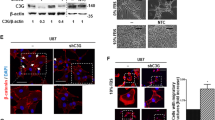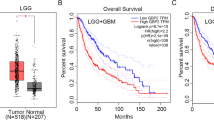Abstract
Heparin-binding epidermal growth factor (EGF)-like growth factor (HBEGF) is a ligand for the EGF receptor (EGFR), one of the most commonly amplified receptor tyrosine kinases (RTKs) in glioblastoma (GBM). While HBEGF has been found to be expressed in a subset of malignant gliomas, its sufficiency for glioma initiation has not been evaluated. In this study, we demonstrate that HBEGF can initiate GBM in mice in the context of Ink4a/Arf and Pten loss, and that these tumors are similar to the classical GBM subtype observed in patients. Isogenic astrocytes from these mice showed activation not only of Egfr but also the RTK Axl in response to HBEGF stimulation. Deletion of either Egfr or Axl decreased the tumorigenic properties of HBEGF-transformed cells; however, only EGFR was able to rescue the phenotype in cells lacking both RTKs indicating that Egfr is required for activation of Axl in this context. Silencing of HBEGF in vivo resulted in tumor regression and significantly increased survival, suggesting that HBEGF may be a clinically relevant target.
This is a preview of subscription content, access via your institution
Access options
Subscribe to this journal
Receive 50 print issues and online access
$259.00 per year
only $5.18 per issue
Buy this article
- Purchase on Springer Link
- Instant access to full article PDF
Prices may be subject to local taxes which are calculated during checkout







Similar content being viewed by others
References
Louis DN, Ohgaki H, Wiestler OD, Cavenee WK, Burger PC, Jouvet A et al. The 2007 WHO classification of tumours of the central nervous system. Acta Neuropathol 2007; 114: 97–109.
Ostrom QT, Gittleman H, Liao P, Rouse C, Chen Y, Dowling J et al. CBTRUS Statistical Report: primary brain and central nervous system tumors diagnosed in the United States in 2007–2011. Neuro Oncol 2014; 16 (Suppl 4): iv1–iv63.
Verhaak RGW, Hoadley KA, Purdom E, Wang V, Qi Y, Wilkerson MD et al. Integrated genomic analysis identifies clinically relevant subtypes of glioblastoma characterized by abnormalities in PDGFRA, IDH1, EGFR, and NF1. Cancer Cell 2010; 17: 98–110.
Brennan CW, Verhaak RGW, McKenna A, Campos B, Noushmehr H, Salama SR et al. The somatic genomic landscape of glioblastoma. Cell 2013; 155: 462–477.
Mishima K, Higashiyama S, Asai A, Yamaoka K, Nagashima Y, Taniguchi N et al. Heparin-binding epidermal growth factor-like growth factor stimulates mitogenic signaling and is highly expressed in human malignant gliomas. Acta Neuropathol 1998; 96: 322–328.
Acquaviva J, Jun HJ, Lessard J, Ruiz R, Zhu H, Donovan M et al. Chronic activation of wild-type epidermal growth factor receptor and loss of Cdkn2a cause mouse glioblastoma formation. Cancer Res 2011; 71: 7198–7206.
Ramnarain DB, Park S, Lee DY, Hatanpaa KJ, Scoggin SO, Otu H et al. Differential gene expression analysis reveals generation of an autocrine loop by a mutant epidermal growth factor receptor in glioma cells. Cancer Res 2006; 66: 867–874.
Ray KC, Moss ME, Franklin JL, Weaver CJ, Higginbotham JN, Song Y et al. Heparin-binding epidermal growth factor-like growth factor eliminates constraints on activated Kras to promote rapid onset of pancreatic neoplasia. Oncogene 2013; 33: 1–9.
Yotsumoto F, Oki E, Tokunaga E, Maehara Y, Kuroki M, Miyamoto S . HB-EGF orchestrates the complex signals involved in triple-negative and trastuzumab-resistant breast cancer. Int J Cancer 2010; 127: 2707–2717.
He C, Lv X, Hua G, Lele SM, Remmenga S, Dong J et al. YAP forms autocrine loops with the ERBB pathway to regulate ovarian cancer initiation and progression. Oncogene 2015; 34: 6040–6054.
Kornblum HI, Zurcher SD, Werb Z, Derynck R, Seroogy KB . Multiple trophic actions of heparin-binding epidermal growth factor (HB-EGF) in the central nervous system. Eur J Neurosci 1999; 11: 3236–3246.
Jin K, Sun Y, Xie L, Batteur S, Mao XO, Smelick C et al. Neurogenesis and aging: FGF-2 and HB-EGF restore neurogenesis in hippocampus and subventricular zone of aged mice. Aging Cell 2003; 2: 175–183.
Puschmann TB, Zandén C, Lebkuechner I, Philippot C, De Pablo Y, Liu J et al. HB-EGF affects astrocyte morphology, proliferation, differentiation, and the expression of intermediate filament proteins. J Neurochem 2014; 128: 878–889.
Ongusaha PP, Kwak JC, Zwible AJ, Macip S, Higashiyama S, Taniguchi N et al. HB-EGF is a potent inducer of tumor growth and angiogenesis. Cancer Res 2004; 64: 5283–5290.
Fu Sl, Bottoli I, Goller M, Vogt PK . Heparin-binding epidermal growth factor-like growth factor, a v-Jun target gene, induces oncogenic transformation. Proc Natl Acad Sci USA 1999; 96: 5716–5721.
Li L, Chakraborty S, Yang C-R, Hatanpaa KJ, Cipher DJ, Puliyappadamba VT et al. An EGFR wild type-EGFRvIII-HB-EGF feed-forward loop regulates the activation of EGFRvIII. Oncogene 2014; 33: 4253–4264.
Vajkoczy P, Knyazev P, Kunkel A, Capelle H, Behrndt S, von Tengg-Kobligk H et al. Dominant-negative inhibition of the Axl receptor tyrosine kinase suppresses brain tumor cell growth and invasion and prolongs survival. Proc Natl Acad Sci USA 2006; 103: 5799–5804.
Hutterer M, Knyazev P, Abate A, Reschke M, Maier H, Stefanova N et al. Axl and growth arrest-specific gene 6 are frequently overexpressed in human gliomas and predict poor prognosis in patients with glioblastoma multiforme. Clin Cancer Res 2008; 14: 130–138.
Robinson JP, VanBrocklin MW, Guilbeault AR, Signorelli DL, Brandner S, Holmen SL . Activated BRAF induces gliomas in mice when combined with Ink4a/Arf loss or Akt activation. Oncogene 2010; 29: 335–344.
Van Brocklin MW, Robinson JP, Lastwika KJ, McKinney AJ, Gach HM, Holmen SL . Ink4a/Arf loss promotes tumor recurrence following Ras inhibition. Neuro Oncol 2012; 14: 34–42.
Aguirre AJ, Bardeesy N, Sinha M, Lopez L, Tuveson Da, Horner J et al. Activated Kras and Ink4a/Arf deficiency cooperate to produce metastatic pancreatic ductal adenocarcinoma. Genes Dev 2003; 17: 3112–3126.
Zheng H, Ying H, Yan H, Kimmelman AC, Hiller DJ, Chen A-J et al. p53 and Pten control neural and glioma stem/progenitor cell renewal and differentiation. Nature 2008; 455: 1129–1133.
Ozawa T, Riester M, Cheng YK, Huse J, Squatrito M, Helmy K et al. Most human non-GCIMP glioblastoma subtypes evolve from a common proneural-like precursor glioma. Cancer Cell 2014; 26: 288–300.
Lu F, Chen Y, Zhao C, Wang H, He D, Xu L et al. Olig2-dependent reciprocal shift in PDGF and EGF receptor signaling regulates tumor phenotype and mitotic growth in malignant glioma. Cancer Cell 2016; 29: 669–683.
Sato S, Drake AW, Tsuji I, Fan J . A potent anti-HB-EGF monoclonal antibody inhibits cancer cell proliferation and multiple angiogenic activities of HB-EGF. PLoS One 2012; 7: e51964.
Holmen SL, Williams BO . Essential role for Ras signaling in glioblastoma maintenance. Cancer Res 2005; 65: 8250–8255.
Kistner A, Gossen M, Zimmermann F, Jerecic J, Ullmer C, Lübbert H et al. Doxycycline-mediated quantitative and tissue-specific control of gene expression in transgenic mice. Proc Natl Acad Sci USA 1996; 93: 10933–10938.
Robinson JP, Vanbrocklin MW, McKinney AJ, Gach HM, Holmen SL . Akt signaling is required for glioblastoma maintenance in vivo. Am J Cancer Res 2011; 1: 155–167.
Zhang Z, Lee JC, Lin L, Olivas V, Au V, LaFramboise T et al. Activation of the AXL kinase causes resistance to EGFR-targeted therapy in lung cancer. Nat Genet 2012; 44: 852–860.
Liu L, Greger J, Shi H, Liu Y, Greshock J, Annan R et al. Novel mechanism of lapatinib resistance in HER2-positive breast tumor cells: Activation of AXL. Cancer Res 2009; 69: 6871–6878.
Meyer AS, Miller MA, Gertler FB, Lauffenburger DA . The receptor AXL diversifies EGFR signaling and limits the response to EGFR-targeted inhibitors in triple-negative breast cancer cells. Sci Signal 2013; 6: ra66.
Cho JH, Robinson JP, Arave RA, Burnett WJ, Kircher DA, Chen G et al. AKT1 activation promotes development of melanoma metastases. Cell Rep 2015; 13: 898–905.
Shin CH, Grossmann AH, Holmen SL, Robinson JP . The BRAF kinase domain promotes the development of gliomas in vivo. Genes Cancer 2015; 6: 9–18.
Sanjana NE, Shalem O, Zhang F . Improved vectors and genome-wide libraries for CRISPR screening. Nat Methods 2014; 11: 783–784.
Hu R, Wallace J, Dahlem TJ, Grunwald DJ, O’Connell RM . Targeting human microRNA genes using engineered Tal-effector nucleases (TALENs). PLoS One 2013; 8: e63074.
Robinson JP, Vanbrocklin MW, Lastwika KJ, McKinney AJ, Brandner S, Holmen SL . Activated MEK cooperates with Ink4a/Arf loss or Akt activation to induce gliomas in vivo. Oncogene 2011; 30: 1341–1350.
Cerami E, Gao J, Dogrusoz U, Gross BE, Sumer SO, Aksoy BA et al. The cBio Cancer Genomics Portal: an open platform for exploring multidimensional cancer genomics data. Cancer Discov 2012; 2: 401–404.
Gao J, Aksoy BA, Dogrusoz U, Dresdner G, Gross B, Sumer SO et al. Integrative analysis of complex cancer genomics and clinical profiles using the cBioPortal. Sci Signal 2013; 6: pl1.
Acknowledgements
We thank the members of the VanBrocklin, McMahon and Holmen labs, as well as E Holland, R DePinho and M Bosenberg for providing mouse strains, reagents and advice. We thank the Huntsman Cancer Institute (HCI) Vivarium staff for assistance. We thank Tim Parnell for his bioinformatics expertise. We acknowledge the use of the Mutation Generation and Detection Core, the DNA Synthesis Core, the DNA Sequencing Core and the Small Animal Imaging Core supported by P30CA042014 awarded to HCI from the National Cancer Institute (NCI). We also acknowledge use of the HCI Shared Resources for high-throughput genomics and bioinformatics analysis, glass wash and research histology. This work was supported by the National Institute of Neurological Disorders and Stroke (NIH R01NS073870, to SLH) and the NCI (NIH F30CA203096, to CHS).
Author information
Authors and Affiliations
Corresponding author
Ethics declarations
Competing interests
The authors declare no conflict of interest.
Additional information
Supplementary Information accompanies this paper on the Oncogene website
Supplementary information
Rights and permissions
About this article
Cite this article
Shin, C., Robinson, J., Sonnen, J. et al. HBEGF promotes gliomagenesis in the context of Ink4a/Arf and Pten loss. Oncogene 36, 4610–4618 (2017). https://doi.org/10.1038/onc.2017.83
Received:
Revised:
Accepted:
Published:
Issue Date:
DOI: https://doi.org/10.1038/onc.2017.83
This article is cited by
-
Image-based deep learning identifies glioblastoma risk groups with genomic and transcriptomic heterogeneity: a multi-center study
European Radiology (2022)
-
microRNA-194 is increased in polycystic ovary syndrome granulosa cell and induce KGN cells apoptosis by direct targeting heparin-binding EGF-like growth factor
Reproductive Biology and Endocrinology (2021)



